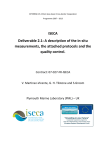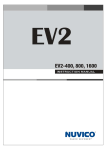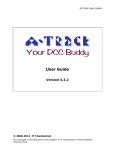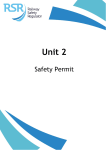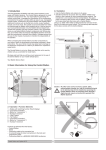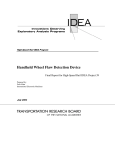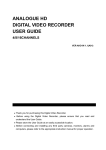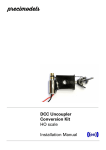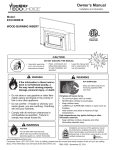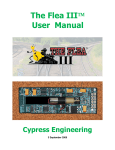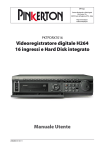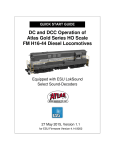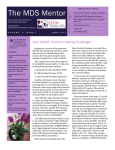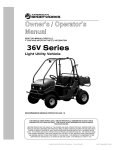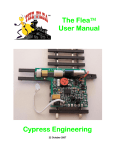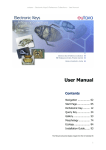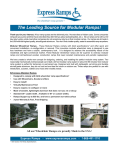Download "user manual"
Transcript
North County Model Railroad Society Member Orientation & Training Guide North County Model Railroad Society Table of Contents I. Member Certification Worksheet II. Member Orientation and Training Guide 1. Member Orientation A. Orientation meetings are the last Saturday of each month following the NCMRS monthly business meeting. B. Introduction 1. Preparation for Operation Operation on the NCMRS Layout requires the completion of 6 training elements: a) Member Orientation Class b) Practical Training Element 1: Cabs and Programming c) Practical Training Element 2: Layout Operations d) Written Examination e) Practical Examination: Cabs and Programming f) Practical Examination: Layout Operations 2. Certified Trainers List 2. Model Railroad Operations A. Practical Training Elements 1. Cabs and Programming a) Setting cab identification number b) Connecting to layout c) Cab display d) Selecting and programming locomotive address e) Advanced consisting 2. Layout Operations a) Fiddle Yard overview b) Layout tour c) Switches and shorts d) Power up and shut down procedures e) Show-N-Go 3. Written Examination 4. Practical Examination 1. Cab and Programming Certification 2. Layout Operations Certification 5. Appendices Table of Contents 2 2/28/09 North County Model Railroad Society Member Certification Worksheet Member Name ___________________________________________________________ Mailing Address __________________________________________________________ City ______________________________________ State _______ Zip ______________ Phone ____________________________________ Phone ________________________ Email ____________________________________ Member Orientation Completion Date ____________ Trainer Name __________________________ Trainer Signature __________________________________________________ Practical Training Elements Cabs and Programming a) Setting cab identification number b) Connecting to layout c) Cab display d) Selecting and programming locomotive address e) Advanced consisting Completion Date ____________ Trainer Name __________________________ Trainer Signature __________________________________________________ Layout Operations a) Fiddle Yard overview b) Layout tour c) Switches and shorts d) Power up and shut down procedures e) Show-N-Go Completion Date ____________ Trainer Name __________________________ Trainer Signature __________________________________________________ Written Examination I have reviewed the examination results with the new member, covering any questions answered incorrectly. The new member understands what was missed. Completion Date ____________ Trainer Name __________________________ Trainer Signature __________________________________________________ Practical Examination Cab and Programming Certification The new member has demonstrated proficiency in all of the elements pertaining to the proper Cab programming and operation. Completion Date ____________ Trainer Name __________________________ Trainer Signature __________________________________________________ Layout Operations Certification The new member has demonstrated proficiency in operating a train on the NCMRS layout. This demonstration tested the member’s ability to properly control a train and operate layout switches without producing a train conflict or layout short. Completion Date ____________ Trainer Name __________________________ Trainer Signature __________________________________________________ Member Certification Worksheet 2 2/28/09 Member Acknowledgement I have reviewed all of the training material, NCMRS policies and procedures and understand the importance of following the established practices. Further, I have had any questions answered to my satisfaction and understand all of the material. I have completed all the requirements for operating on the NCMRS layout. Completion Date ____________ Member Name _________________________ Member Signature _________________________________________________ Final Member Certification I have reviewed the member’s training record, answered all new member questions, and personally administered the practical examination. The member has completed all certification requirements for operating on the NCMRS layout. Completion Date ____________ Trainer Name __________________________ Trainer Signature __________________________________________________ Member Certification Worksheet 3 2/28/09 North County Model Railroad Society Member Orientation North County Model Railroad Society CONTENTS Mission Statement ........................................................................................ 2 Location........................................................................................................ 2 1. Introduction ............................................................................................. 2 2. Dues, Badges, Shirts, Keys and Fees .................................................... 3 3. Elevator and Stairwell Usage .................................................................. 3 4. Club Rules ........................................................................................... 3,4 5. Last-member-out Procedure ................................................................... 4 6. Business Meetings .................................................................................. 4 7. Policy on statements made to media ...................................................... 5 8. Relationship to other clubs...................................................................... 5 9. Donations to the Club ............................................................................. 5 10. Railroad Operation ............................................................................... 5,6 11. Club History ......................................................................................... 7-9 1 Mission Statement The North County Model Railroad Society is a not-forprofit benefit corporation whose mission is to share the hobby of model railroading, encourage awareness of railroads both yesterday and today, and to provide rail safety education to the northern San Diego County community. Location On the second floor above Boney’s Marketplace 1820 Oceanside Blvd. Oceanside, CA 92054-3452 Tel. (760)722-7366 Website www.NCMRS.org 1. Introduction Welcome to the North County Model Railroad Society. We are pleased you have joined us and look forward to you being an active and involved member and hope that this document will provide you with the information you need to function smoothly in the club. Do not hesitate to ask, if you have any question, and feel free to share your ideas for making membership in our club a great experience. The club is organized under California law as a not-for-profit public benefit corporation. Each year at the December business meeting, the members elect three members in good standing to the Board of Directors. These directors appoint the officers: President, Vice-President, Secretary, and Treasurer. The President may create and dissolve committees as needed and appoint members to these committees and select the chairperson. More information about the club organization can be found the in the bylaws. Officers – 2009 President Vice-President Secretary Treasurer The Board of Directors - 2009 Chairman Al Cuevas CFO Dick Miller Secretary Phil Schneider Member Orientation 2 Dick Miller Lyle Lodwick Burt Gray Nick Ruddick 2/28/09 2. Dues, Badges, Shirts, Keys and Fees Badges, Shirts and Hats: Members are required to wear a badge at the club and at all club functions. Badges are $5 each. You can order additional badges for your spouse, children, and grandchildren if you wish. Club shirts are available and you are encouraged to purchase at least one and wear it at the club and at club events. Club baseball hats are also available. Dues: Currently $25 per month and due before the first of the month. Checks are preferred and should be left in the grey box in the Fiddle Yard. Keys: Each member is charged a $10 key fee when joining the club. This entitles the member to a key for the elevator (one per family) and to the entry door into the NCMRS Club. If a key is lost, a $5 fee will be charged for each key requiring replacement. In addition, the main entry door has an access code which you will be given when you join. Keys may not be distributed to any youth member or loaned to anyone under any circumstances. 3. Elevator and Stairwell Usage The elevator on the first floor is called by inserting the key in the upper lock to the left of the elevator, turning it clockwise about 30 degrees, turning it back, and removing it. Do not leave the key inserted for more than a few seconds or remove the key in the angled position. Doing either will cause an alarm to sound until the lock is returned to the straight up-and-down position. The elevator call on the second floor is a conventional elevator call button. The stairs at the end of the second floor hall may be used by club members. Guests are discouraged from using them. The door between the club’s upstairs elevator foyer and the hallway where the restrooms are located is to be kept locked except during open house hours. At other times, please unlock it when using the restroom and relock it on your way back to the club. Please note that there is another set of stairs in the diagonally-opposite corner of the building; use these in an emergency if appropriate. 4. Club Rules Expected behavior: You are expected to be cordial and friendly to your fellow members, our guests and visitors, and to Boney’s personnel and customers. Note: You are required to wear you badge when you are at the club as it identifies you to the store staff as someone allowed upstairs. Work days: Tuesdays are run days. Thursdays are work days. Saturdays are a combination of work and run activities. We are also open to the public on Thursday afternoons and Saturdays. Member Orientation 3 2/28/09 Non-work days: You may visit the club any day for work projects, however you are not permitted to run any train on the layout unless you have completed certification procedures. Property: Members may not use another member’s property (engines, rolling stock, tools, etc.) without approval. Exception: member’s rolling stock left on the layout may be moved. Member’s rolling stock is not to be left on the fiddle yard tracks. Intoxicants: No intoxicants or smoking material of any kind are allowed on the club premises. Visitors: From time to time and especially on Saturdays, we will have visitors. Be a good host. You are expected to be friendly and attentive, answer questions, show them around, explain our layout, and instruct children how to run the demonstration layout. 5. Last-member-out Procedure If you are the last one to leave the club, make sure the following things are done: • General tidying up and putting things away • Coffeemaker filter and grounds are placed in trash, filter basket rinsed, pot emptied and rinsed, spilled coffee and grounds wiped up • Open food put in the refrigerator (remember this is a food store and food should never be left out) • Trash emptied • Workbench cleared and left tidy • Back door closed and locked • Show-N-Go layout power switched off • Main layout power switched off • Programming track power switched off • Shopping carts returned • Fans off, music off, lights off • Front door closed and locked Even if you are not the last member, please help your fellow club members by assisting with the items on this list. 6. Business Meetings Monthly business meetings take place at the club on the last Saturday of each month at 10 AM. Exceptions may be made by the President. This usually occurs if there is a conflict because of a holiday. Members are expected, but not required, to attend these meetings. Our bylaws specify a minimum of one third of the membership is required to have a quorum (minimum number needed to call a meeting to order). If you cannot attend a meeting you have the option of giving a proxy to another member. This means that the member with your proxy can cast your vote either, as he or she sees fit, or as you have directed them. Proxies count towards a quorum. Member Orientation 4 2/28/09 7. Policy on statement made to media Members should direct inquiries form reporters and professional photographers to a club officer or, if on is appointed, to the member specifically responsible for media relations. 8. Relationship to other clubs While each group and club has a unique culture, mission, and set of requirements, we are all bound together by a shared passion for the hobby of model railroading. We respect members of other clubs. Model railroad clubs interact co-operatively and never competitively. Never speak of another club’s or individual’s layout or rolling stock in a derogatory way. We are all at some point on a path towards mastery. 9. Donations to the Club The NCMRS has been granted tax exempt status under section 501(c)(3) of the Federal tax code by the IRS effective on August 22, 2005. This means that contributions to the club are deductible. It also means the club is eligible to receive bequests (gifts bestowed in wills). Here is an incomplete list of things that are NOT deductible: Club dues Purchases from the club Raffle tickets Donated items received before August 22, 2005 The club is required to issue a letter acknowledging cash gifts of $250 or more. The letter must state the name and tax ID number of the club, the amount received, the name of the person or organization giving the gift, and the date received. We also must issue a letter acknowledging non-cash gifts stating the name and tax ID number of the club, the name of the person or organization giving the gift, a detailed description of the gift, and the date received. The club will not state a value for non-cash gifts. It is the policy of NCMRS to acknowledge all cash gifts of $20 or more. 10. Railroad Operation In order to run your trains on the railroad you are required to complete the six training elements found on the Member Certification Worksheet and complete the Member Acknowledgement and Final Member Certification. In addition, you must have your engines and rolling stock checked by the Maintenance Department for compliance with club standards. Note, any of the procedures referenced in this section can be found on our website at www.ncmrs.org. Member Orientation 5 2/28/09 Main Layout Operation: To operate on the Main Layout a member must complete the training program (6 element program) contained in this Member Orientation and Training Guide. A Member Certification Worksheet tracks your progress through the program and is contained in this manual. You may commence the program immediately upon becoming a member by contacting any NCMRS officer or Certified Trainer. The training is both informative and fun. During the process you’ll meet a number of other members, all enjoying the same hobby…model railroading. While the training program is comprehensive, it can be completed fairly quickly as the program is individually based. That is, all of the elements may be completed individually, without the need to wait for a formal class schedule. While the Orientation Class is held monthly, you may even complete this element individually if a class is several weeks away. You will find your knowledge and enjoyment of the NCMRS will continue to grow as you become involved and take on new challenges (perhaps volunteering for various committees, etc.. A list of Certified Trainers is included in this manual…feel free to seek them out. Upon completion of the program, your trainer will sign your Member Certification Worksheet and file it with the officers of the NCMRS. Rolling Stock Standards: You are required to have any engines and rolling stock that you wish to run at the club checked by a member of the Maintenance Department for compliance with club rolling stock standards. Track Cleaning Procedure: Prior to any formal operating or informal operating session it is required that mainline, passing sidings, and major spurs be cleaned according to the procedure. Engine Programming: If you need help programming your engine, ask for assistance. Engines can be programmed on the demonstration layout or on the programming track across from the fiddle yard. You are required to register your engine prior to programming. Make sure your engine number is not already taken. Rolling Stock Identification: You are encouraged to register your rolling stock’s identification marking. The Registration Log is posted on the bulletin board. Formal Operating Sessions: The club has a formal operating session on the second Tuesday of the month. Trains are operated with an engineer and conductor team. After completing the required checkout procedures, you may participate. NOTE: Based on the size and amount of fiddle yard space and as courtesy to your fellow members, you are asked to have only one train on the layout at a time. Member Orientation 6 2/28/09 11. Club History • History 1990 through 2002: Written by Co-founder Cyrus Grimshaw. Cyrus Grimshaw, John King and Jeff Warner formed the club in January 1990. The three of them had been visitors at Bob Bethel's American Hobby Supply in San Marcos asking whether there was a train club in the area that they could join. Bob's answer was that none existed, so why not start one? He put them in touch with one another and it was quickly decide that a modular approach would be the best way to go since modules would be easy to assemble, disassemble, move, and store. Displays were arranged in 1990-1991 at the Carlsbad Train Station, American Hobby in San Marcos, Short Lines Junction (now Reed's) in Escondido, Pacific Southwest Region Convention in San Bernardino, and the Great American Train Show in San Diego. Additional members were recruited and by 1991 the club was ready to rent a small storefront to allow permanent set-up of the modules and to serve as a meeting place for the members. The first location was at 817 San Marcos Boulevard, only two doors away from American Hobby Supply. There was room for about a dozen modules in the rear and a small meeting area in front. That front space soon disappeared when two N-Scale modelers asked for module space and got quick approval for it. By 1992 the number of members had increased to where additional space would be required. Thanks to Dan Reid, one of the club members, we moved into new quarters at 2642 Oceanside Boulevard and were able to expand to almost 1800 square feet of floor space. We doubled the size of the N-Scale layout and split the HO-Scale into Eastern and Western Divisions. 1994 brought about the temporary loss of the Oceanside Boulevard location, and all modules were placed in storage while a search went on for a new home. Fortunately, Cy Grimshaw made contact with the Palm Tree Plaza management and an agreement was reached on one of the storefronts at the corner of South Melrose and Cannon Road in Oceanside. The club moved into Suite 2H in the spring of 1994 and remained in the Plaza until January of 2001. The management was very supportive of the club and while we had to move into different suites over the years, we never lost a space until January 2001. To complicate our move, we even put up an N-Scale layout display at the Dec. 2000 Great American Train Show. We were again able to locate an agreeable management and moved into 1360 East Mission Road in Jan. 2001. We struggled for awhile with no power while an electrical panel was modified to provide 110 volt power and in April 2001 had a "Grand Reopening" with almost 400 plus visitors over a weekend. The club was again off and running. In 2002, the club voted to redo the HO-Scale layout to emphasize railroad-type operation and construction of all-new modules and Member Orientation 7 2/28/09 control systems began. About that time, dwindling interest in the N-scale layout resulted in a decision to abandon N-scale and focus the club’s resource solely on HO. • History 2002 through 2006: Written by then Club President, Al Cuevas. The club, then known as North County Modular Railroad Society, remained in the San Marcos location until late 2004. In 2004, the club applied for a 501(c)(3) status. This was approved and became effective in mid 2005. At the same time the club received a notice to vacate the current location in east San Marcos. After much searching, an agreement was reached with the owner of Boney’s Supermarket in Oceanside to lease a small area of their upstairs warehouse. In December of 2004 the club moved to the second floor of Boney’s. By mid January 2005 we had built our room, installed lights, set up our traveling layout and were working on developing a plan for our permanent layout. In April 2005 the layout was finalized and construction began on our new permanent layout. The summer of 2005 brought word form the IRS that the club’s application for a not-for-profit 501 (c)(3) status was approved and became effective. During this time we had a very active membership recruitment campaign. A number of new people joined the club bringing our membership to just under forty members. Some of these people have become very active. In late 2005 our mainline track had been completed to the point that members could run trains. Scenery was being developed along the first peninsula. During the first half of 2006 scenery work continued and a few areas started looking complete. Members ran their trains not only for their own enjoyment but to test the track. A four camera monitor was installed to allow engineers to see into the blind areas when running trains through the partition. Since our beginnings at Boney’s we have been holding open houses on every Saturday from 10 am until 3 pm. That has expanded to Thursdays. We have been featured in two cable TV shows along with newspaper articles in the San Diego Union Tribune and North County Times. As the Sprinter approaches operational status, some of our members will be conducting “Operation Lifesaver” classes. The purpose of these classes is to inform the public about rail safety. Target audiences will be schools, Boy and Girl Scout groups and people located along the Sprinter route. • History 2006 through April 2008: Written by Club President, Dick Miller Our club continues to be very active. In December of 2007 we celebrated our third anniversary at Boney’s. Since we have moved to Boney’s we have doubled our membership to 48. Two of the four peninsulas on the layout are nearly complete. Construction and scenery work continues on the two remaining peninsulas. Member Orientation 8 2/28/09 In 2007 we upgraded our DCC control system to NCE. The user friendly NCE throttles are will liked by the membership. On January 1, 2008 the club acquired an additional 900 square feet of space. This expansion added a business office, a maintenance area, a work area, a lounge, and additional layout space. Spring of 2008 saw the entry area overhauled to make the club more inviting and visitor friendly. Member Orientation 9 2/28/09 North County Model Railroad Society Certified Trainers Types of Membership: ♦ Uncertified Member – A member of the NCMRS with all membership privileges except operating on the Main Layout. May be a member of any committee and complete scenery, electrical or any other function or task for which they are qualified. An Uncertified Member need only complete the member Orientation Class. ♦ Certified Member/Operator – A member with all of the rights of an Uncertified Member plus operating on the Main Layout. To become a Certified Member, all 6 training elements must be completed and signed off on the Member Certification Worksheet (the Worksheet will be retained in a binder by the officers of the NCMRS). A Certified Member/Operator may not train an Uncertified Member. ♦ Certified Trainer – A member who has all of the rights of a Certified Member/Operator and who has completed a special training class to train members on the Main Layout. These Certified Trainers will ensure that members are not “partially trained”. Certified Trainers have volunteered to use their own engines in the training process. General Trainers regularly operate on the Main Layout and may complete all elements of the training program while Specialty Trainers have a unique understanding of various training elements and may present and sign-off those selected modules. All sign-off must be recorded on the Member Certification Worksheet to be effective. General Trainers: Specialty Trainers: 1. 2. 3. 4. 5. 6. 7. Al Cuevas Lyle Lodwick Charlie Tucker Bill Daly Kevin Harper Terry Kirkpatrick Leo Valley 1. Dick Miller - Orientation 2. Jay Sarno - Orientation 3. Cliff Anderson – Cabs & Programming 2/28/09 North County Model Railroad Society Practical Training Elements Cab and Programming North County Model Railroad Society Cabs and Programming Procedure Introduction All of the NCMRS owned and all members owned NCE ProCabs use a coiled cord. A flat telephone connector is at one end of the cord. A round five pin DIN connector, with a right angled jack, is on the other end. The NCE ProCab and the NCE Power Cab look almost identical and for our purposes behave identically. In this document, we will make no further distinction between the ProCab and the Power Cab, using the term “ProCab” to cover both. ProCab throttle with coiled cable and Right Angle DIN connector. 1. Setting the Cab Identification Number (To Be Done One Time Only!) Each ProCab has an internally programmed cab identification number. If you are using a NCMRS-owned ProCab, its identification number is on a label on the back. You can skip this section and proceed to Section 2. A list of NCMRS-owned ProCab identification numbers is posted on the club Bulletin Board adjacent to the Fiddle Yard. Numbers are listed as Club-Owned, Reserved, Assigned, or Available. If you have not been assigned a number, select one from the Available list. Enter your name in the appropriate place in the list. This process is intended to prevent the next member from taking the same choice. Only your assigned personal number can be used on your ProCab. If your ProCab has already been Assigned, skip the rest of this Section, and proceed to Section 2. If you are using your own personal ProCab for the first time, use the following procedure to “Assign” it the number you have chosen. You only will have to do this once. No member may obtain assignment of more than one number. Do this step on the workbench system where we have the Programming Track: Do not do it on the main layout system! While holding down the SELECT LOCO button of your ProCab, plug it into the Command Station. Enter an Available number into the ProCab (for example, press 5 followed by 6 to assign Cab ID 56). Then press the ENTER button. If you make a mistake, unplug the ProCab and start over. (To verify the Cab ID without changing it, press ENTER without a new Cab ID). This prompt will appear on the ProCab display. YARD OR NORMAL 1=YARD 2=NORM 2 Press 2 followed by ENTER . Press PROG/ESC to complete the assignment. “Yard” mode configuration may be implemented on your personal ProCab. At present, do NOT use Yard mode on an NCMRS-owned ProCab! As a final step, verify that your ProCab reports the Cab Address that you just assigned it. More advanced ProCab features are described in the PowerPro System Reference Manual, Published by NCE. At the present time, these features must not be used on the NCMRS layout. 2. Connecting: This exercise can be done either on the programming track system or in the fiddle yards area of the main layout. Cab and Programming 2 2/28/09 Step 1: Verify that the NCMRS layout is powered up and ready to run. If you need help, ask an experienced member for a demonstration. For further information, refer to the North County Model Railroad Society Member’s Manual, Paragraph II.A.1. Step 2: The NCMRS ProCab uses a tethered throttle cord. A flat Telephone connector is at one end. A round five pin DIN connector, with a right angled jack, is on the other end. Plug the Telephone connector into the base of the ProCab. Notice that there is only one correct orientation! Plug the DIN connector into an available round DIN socket that is attached to the lower right shelf above the workbench or any of those the within the fiddle yard. (The Din sockets are located on anodized aluminum squares along the layout fascia). The correct orientation is with the cord at the bottom of the right angle jack, as in this photograph. Right angle DIN connector correctly plugged into a fascia plate. Please use the Programming Track or else stay within the fiddle yard for this exercise. Cab and Programming 3 2/28/09 The screen of the ProCab will light up. The display will look like this momentarily: NCE PROCAB V1.3 CAB ADDRESS = 23 You may have to unplug and plug in again to actually see this display. The two digit number in the lower right corner of this display is the ProCab ID number, your ProCab should display your number and probably not the “23” represented here and chosen as a typical value. Under no circumstances should your ProCab have address “02.” (A yellow background in this document highlights the important areas of the display.) After approximately one second, the display will change to something similar to one of these: LOC:1234 12:01AM FWD:123 L123456 CON: 099 12:01AM REV:000 ------These displays tell you about the previous locomotive or consist (if any) that was assigned. The first line tells you that either a locomotive “LOC:” or else a consist “CON:” was assigned. It provides the one to four digit number for the locomotive or consist. The first line also displays the current value of the “Fast Time” clock. For this exercise, you may ignore the clock. The second line tells you the direction of the train “FWD” or “REV”. The second line also shows the speed step setting of the locomotive or consist (“123” in the “LOC:” illustration and “000” or stopped in the “CON” illustration). Finally, the second line also shows the state of the first seven of the locomotive’s function outputs (“L123-56” in the “LOC:” example, where “-” indicates OFF and a letter or numeral indicates which ones are ON). See the Power Pro System Reference Manual for a description of the output functions. Cab and Programming 4 2/28/09 Step 3: If the first line of the display shows “LOC:” skip this step and proceed to Step 4. For this exercise, we want to only discuss Locomotive. If your display shows “CON:”, locate the ProCab key group that is labeled “CONSIST” that is the boxed in second row of buttons from the bottom. Press the CLEAR key in that row and follow the instructions that are displayed to kill any remnant consist attached to this ProCab. About Consists: Preparation and operation of consists, using the NCE ProCab, is explained in another document. Do not attempt to prepare and operate consists until you have mastered the contents of this manual. Step 4: Press the SELECT LOCO key. The ProCab expects you to identify your locomotive using a one to four digit “short” or “long” DCC locomotive address. A flashing black square appears on the screen where you enter the next number. For an individual locomotive, always use a long address. Short addresses are RESERVED for consists! New locomotives are often shipped with address 03. Under no circumstances should this address be used on the layout. Change the address to the road number address on the programming track. If your locomotive is set to respond to a long address (0000 – 9999), but has a number below 128, you must enter a leading zero before the number (example: enter 63 as 0 6 3). If your locomotive has a three digit address above 127 just enter the number (example: for 345, press 3 4 5). In either case, press the ENTER key to accept the new locomotive address. A locomotive with a long address and a number between 1 and 127 will be displayed with an asterisk followed by three digits. LOC:*123 12:01AM FWD:000 ------Caution: A locomotive with a short address will be shown on the display as a one, two, or three digit number without an asterisk. LOC: 123 12:01AM FWD:000 ------- Cab and Programming 5 2/28/09 If your locomotive has a short address, you must reprogram it to use a long address. Consult your locomotive’s User’s Manual to learn how to do this. If you hit a wrong digit key while choosing a locomotive, keep pressing numbers until the display clears. Then try again. Pressing the ENTER key accepts the new locomotive address. (If you press PROG/ESC key before the ENTER key, you will exit the select loco function without changing the current locomotive address.) Step 5: Press the 28/128 key to toggle between 28 speed steps and 128 speed steps. The display will toggle back and forth between screens similar to these: LOC:3756 12:01AM FWD:000 SP: 28 LOC:3756 12:01AM FWD:000 SP:128 The NCE system cannot use decoders that are limited to 14 speed steps. You must replace any decoder limited to this choice. If your locomotive decoder is capable of 14 and 28 speed steps, make sure the decoder is programmed for 28 speed steps. Some of the older locomotive decoders may not work if the ProCab is set to 128 speed steps. If the locomotive decoder is capable of 28 and 128 speed steps, either setting of the ProCab speed steps is acceptable. Decoders that are capable of 28 and 128 will automatically detect which kind of signal they are receiving and will respond correctly. Press the ENTER key when you have selected the option that is consistent with the way your locomotive is programmed. Step 6: You are now ready to verify control of your locomotive. Any of the following tests may be used to do this. 1. If your locomotive is equipped with working headlight, the headlight is toggled on and off by either the HEADLIGHT key or the 0 key. Cab and Programming 6 2/28/09 2. If your locomotive has sound functions, and they are turned on, the bell is toggled on and off by either the BELL key or the 1 key. (Early sound decoders may require you to use the 3 key for the bell. However, some early sound decoders may be reprogrammed to use the BELL or 1 key.) 3. If your locomotive has sound functions and they are turned on, the horn or whistle will sound under either of these two conditions: a. If you hold down the HORN / WHISTLE key (causes momentary blow). b. If you press the 2 key (toggles whistle/horn on and off). If your locomotive is equipped for sound, but does not respond in cases (2) or (3), it may be because the sound functions are turned off. Press the appropriate key or sequence for your decoder to turn them on, and repeat step (2) or (3). 3. Running in the Fiddle Yard or on the Test Track. CAUTION: Before starting, make sure your ProCab is NOT in Yard mode! If the speed indictor goes to “REV” when you spin the wheel downward, the ProCab is in “Yard” mode. Refer to the Appendix to learn how to restore “Normal” mode. DO NOT USE YARD MODE UNLESS YOU DISCUSS IT WITH A QUALIFIED MEMBER! Press the DIRECTION key to toggle between “FWD” or “REV”. To set the speed, do one of the following: 1. Roll the SPEED Thumbwheel upward to increase or downward to decrease the throttle setting. 2. Press the INC and DEC keys to increase or decrease the throttle setting one step at a time. 3. Press the INC FAST and DEC FAST keys to increase or decrease the throttle setting by several steps at a time. If your throttle is set for 28 speed steps, the increment and decrement will be 4 steps for each time you press one of these keys (to a maximum of 28). If your throttle is set for 126 speed steps, the increment and decrement will be 10 steps for each time you press one of these keys (to a maximum of 126!). Cab and Programming 7 2/28/09 4. Locomotive Emergency Stop If an emergency occurs to your locomotive only, you may stop it quickly by pressing the EMERGENCY STOP key exactly ONCE. The momentum setting for your locomotive will be ignored, and your train will come to a sudden stop. The previous value of your speed setting will be retained in the system memory and the ProCab display. After clearing the emergency, press any of the DIRECTION, INC FAST, DEC FAST, INC, or DEC keys will cause the locomotive to resume at approximately its previous speed. (Caution: If you use the DIRECTION key the locomotive direction will be reversed, and the train will resume at its previous speed.) 5. System Emergency Stop (To Be Avoided Unless Absolutely Necessary!) If you press the EMERGENCY STOP key three times in succession (without another intervening key press), you will stop all trains on the layout! Only your ProCab will be able to cancel the emergency stop. A display similar to this will show on all active ProCabs: LOC:3756 12:01AM E-STOP BY CAB 23 The throttle number of the ProCab that caused the stop is displayed on ALL ProCabs. To restart the system after clearing the emergency, you must press the ENTER key on the same throttle to clear the System Emergency Stop. No other throttle can be used for this purpose. Each ProCab will have to be then cleared. If a System Emergency Stop occurs, it is imperative that the causing throttle clear the emergency before its operator leaves the layout. AFTER the System Emergency Stop is cleared, other throttles each may be restarted by pressing a speed change key, or a function toggle key, such as bell, whistle/horn, etc. 6. Returning a Club Owned Throttle: If you are using a club-owned ProCab, you must do the following before leaving the layout. 1. If you have used a personal consist (see Paragraph 2, Step 3 on page 5). 2. Set the Locomotive Number long address 00 (see Paragraph 2, Step 4 on page 5). 3. Return the Throttle and cable to the Club Throttle Storage Location. Cab and Programming 8 2/28/09 North County Model Railroad Society ADVANCED CONSISTS EXPLAINED Basic decoders that have a short address but no CONSIST address (Early Lenz, MRC 30x/31x series and Digitrax 120 series Decoders) can not be used with advanced consisting. ADVANCED CONSISTS Decoders that support advanced consisting have an additional short address, the CONSIST address, in addition to their normal Long and Short addresses. The consist address is stored in CV19 and can have a value of 112-127. A decoder considers itself in a consist if the Consist Address (CV19) is something other than 0 or 128. A decoder is added to a consist when the command station sends a command to set the consist address in the decoder to the consist number. The decoder will now use this new address for speed and direction commands. This has many advantages including the need for fewer communications on the track and no need for the operator or command station to keep track of which locomotives are in what consist on the layout. Each locomotive in an advanced consist will still respond to function or programming commands using the original locomotive address. This means the operator can turn lights or other functions on or off for each locomotive individually. To kill an entire consist, a command is broadcast on the tracks for each decoder with that consist number to clear its consist address and return to individual operation. Locomotives can also be individually dropped from a consist. You can also add locomotives to a consist after the initial set up of that consist. Advanced style consists can easily be taken from layout to layout and they will continue to operate as a single unit. SETTING UP AN ADVANCED CONSIST To set up a consist press SETUP. This screen allows you to choose the type of consist to be created. For those consists that will contain advanced decoders, press ENTER to select the advanced mode. CONSIST ENTER=ADV 2:00 PM 1=OLD An advanced consist has no limit to the number of loco’s assigned. NOTE: you can not setup, add, or delete a loco from a consist while the locomotive is moving. It must be at speed 0. Decoders will not accept consist commands while they are in motion. This prevents reception of false consist make/break commands due to electrical noise generated by the wheels rolling on the track. CONSIST ADDRESS: The consist address can be any number from 4 through 127. The system will suggest the first available consist address (the priority is highest to lowest). Press ENTER to accept this address. SETUP CON ADDR: 2:00 PM 127 You may enter any other number you wish (up to 127) then press the ENTER key. Locomotives are not allowed on the layout using short addresses. Make sure you don’t pick an address already in use. This is one reason to use long addresses with your loco fleet. It will keep the short addresses free for consists. ENTERING THE LEAD LOCO NUMBER Entering the lead loco number is recommended. The command station keeps track of consists by their lead loco number. This locomotive is the loco that the command station will send function commands to. For example: headlight on/off commands. If the command station did not know the lead loco it would not know which locomotive should have the headlights turned on or off. The lead loco number also acts as an alias for the consist number entered above. Say you have a bunch of consists stored on staging tracks and you wish to operate one of them. After the consist is set up, you can select the consist by pressing SEL LOCO then entering either the lead loco number or the consist number. The lead loco number is typically easiest to remember because it is the number printed right on the locomotive. The consist address may not relate to any visible or easily remembered number. SETUP LEAD LOCO: 2:00PM Enter the lead loco number followed by pressing the ENTER key. ENTERING THE LEAD LOCO DIRECTION If the locomotive is to operate in the forward direction press ENTER. Press the DIRECTION key if you wish to have the locomotive operate in the reverse direction. Subsequent presses of the DIRECTION key will keep changing the direction. When you get the direction you desire press the ENTER key. CONSIST DIR THIS LOCO: Advanced Consists Explained 2:00PM F 2 2/28/09 This informs the decoder whether the loco is in the line-up facing forward or reverse. For instance, in an A-B-A consist the lead A unit and the B unit will be setup in the Forward direction, and the second A unit will be setup in the Reverse direction. ENTERING THE REAR LOCO NUMBER Entering the rear loco number is optional. The command station keeps track of consists by their lead or rear loco number. If you select the consist by the rear loco number the direction of the consist will be reversed from the direction of operation if you selected it by the lead loco. You don’t have to enter a rear loco number if you don’t need/want to operate the consist in reverse. The rear loco number also act as an alias for the consist number just as the lead loco number. SETUP REAR LOCO: 2:00PM Enter the rear loco number followed by the ENTER key. NOTE: If you plan on dropping the rear loco from the consist later on, DO NOT enter it as the rear loco. Enter it later on when prompted for mid-consist locos. ENTERING THE REAR LOCO DIRECTION If the locomotive is to operate in the normal direction press ENTER. Press the DIRECTION key if you wish to have the locomotive operate in the reverse direction. Subsequent presses of the DIRECTION key will keep changing the direction. When you get the direction you desire press the ENTER key. CONSIST DIR THIS LOCO: 2:00PM F ADDING A MID-CONSIST LOCO At this point you can add more locomotive to the consist. Enter the next locomotive (decoder address) followed by pressing the ENTER key. If you don’t want to add any more locomotives to the consist just press ENTER. CONSIST ADD LOCO: 2:00PM ENTERING THE LOCO’S DIRECTION CONSIST DIR THIS LOCO: Advanced Consists Explained 2:00PM F 3 2/28/09 As with the lead locomotive, this informs the decoder if the loco is in the line-up facing forward or reverse. If the locomotive is to operate in the normal direction press ENTER. Press the DIRECTION key if you wish to have the locomotive operate in the reverse direction. Subsequent presses of the DIRECTION key will keep changing the direction. When you get the direction you desire press the ENTER key. At this point you will be prompted to add additional locomotives. If you don’t want to add any more locomotives to the consist just press ENTER or PROG/ESC with out entering an address. DROPPING A LOCOMOTIVE FROM AN ADVANCED CONSIST To delete a consist locomotive press DEL. DEL LOCO ENTER LOCO: 2:00PM This will drop the loco identified from whatever consist it was part of. There is no need to know the consist number for this operation. You cannot drop a lead or rear loco without clearing the entire consist. Deleting a loco sets CV19 to a value of 0 in that loco. ADDING A LOCO TO AN ADVANCED CONSIST Select the consist. ADD LOCO CONSIST ADDR: 2:00PM Press ADD. Enter the address of the consist, or lead loco, to which the loco is to be added and then press the ENTER key. ADD LOCO ADD LOCO: 2:00PM Enter the loco number to be added and press the ENTER key. Enter the loco’s direction. CONSIST DIR THIS LOCO: 2:00PM F If the loco is to operate in the normal direction press ENTER, otherwise press the DIRECTION key followed by pressing the ENTER key. This informs the decoder whether the locomotive is in the line-up facing reverse. Advanced Consists Explained 4 2/28/09 CLEARING AN ADVANCED CONSIST Press CLEAR. Select the consist to be cleared. LOCO: 4449 KILL CONSIST: 2:00PM Enter the lead or rear loco number and press ENTER. This sends a command to all decoders with this consist address to clear the consist address from the decoder. You can also enter the consist address if you know it. All locomotives that were assigned to this consist will no longer respond to the consist address. CHANGING THE LEAD/REAR LOCO Under some circumstances it is desirable to change which locomotive is to act as the lead loco of a consist. One of these circumstances is when you want to drop the lead/rear loco from the consist. The command station will not allow you to drop the lead/rear loco so you will want to assign a new locomotive as lead/rear. Then you will be able to drop the old lead loco. SETUP CON ADDR: 2:00PM The first step is to press SETUP. Then enter the consist number of the current lead loco number (address). Then press ENTER. SETUP LEAD LOCO: 2:00PM Enter the new lead loco and press ENTER. If the new lead loco is to operate in the forward direction press ENTER. Press the DIRECTION key if you wish to have the locomotive operate in the reverse direction. When you get the direction you desire press the ENTER key. CONSIST DIR THIS LOCO: 2:00PM F You are now finished changing the lead locomotive of the consist. Use a similar procedure to change the rear loco. Advanced Consists Explained 5 2/28/09 North County Model Railroad Society Practical Training Elements Layout Operations North County Model Railroad Society Layout Operations Training Information Operational check refers to learning how to run your train on the club’s fixed layout. Before you can run your train on the layout you MUST be checked out by a Certified Trainer. Learning as much as possible about the layout will help you have a good experience. It will also help protect the large investment both in time and money that previous members have made. Successful completion of this checkout requires the member to demonstrate competency in running their train around the layout. During this checkout, a member caused short can be cause for failure. Follow the following guidelines to get started. 1. Clean track and wheels before running. The club has three different types of cleaning cars. You SHOULD clean the track with the club cars every time you run. 2. Engines and rolling stock should only be put on the tracks in the fiddle yard with the track power OFF on the track that you are using. After you have put all of your rolling stock on the track and you are sure that all of the wheels are on correctly, then turn track power ON. 3. Before leaving the fiddle yard, check the track ahead. Be alert for other train movements. Make sure that no one is coming opposite direction or stopped ahead of you. 4. Stay with your train. You must be able to see your train at all times and the track ahead of it. Do not get distracted. If you can’t see your train or have to do something else, stop your train first. 5. Look ahead! Plan ahead! Think of where your train will be in 30 seconds. Are there any turnouts? If so, they need to be checked for correct position. This check can be done with a visual check on the turnout or with the green or red lights on powered throws. 6. Do no cause shorts. They are avoidable. If you are getting multiple shorts (more than one) you are doing something wrong. STOP IT! Shorts damage the system. We have a three strikes and you are out policy. Three shorts and you have to take your train off the layout. 2/28/09 Layout Operations Training Procedures Your Certified Trainer will demonstrate the following procedures required to successfully pass the Practical Examination to be completed later in this training program. Please be certain you understand how to properly complete each of the following…ask questions as the Certified Trainer is demonstrating the procedures. 1. How to turn the layout power on. 2. How to turn the layout power off. 3. How to turn individual fiddle tracks on. 4. How to turn individual fiddle tracks off. 5. How to put the engine and rolling stock on the track in the fiddle yard. 6. How to prevent shorts while leaving the fiddle yard and making a circuit of the lower and upper tracks. 7. How to maintain control of your engine and rolling stock during a run on the layout. 8. How to anticipate switching needs given the flow of traffic on the layout and the route being taken. Turnout use and control. 9. How to clean the tracks and wheels and that you know how to use the club cleaning cars properly. 2/28/09 North County Model Railroad Society Written Examination North County Model Railroad Society WRITTEN EXAMINATION The degree of enjoyment we each experience at the club is directly related to our willingness to respect others and abide by a common set of rules designed for the benefit of all members. The following written examination is designed to test and reinforce your understanding of the policies, procedures, practices and safety precautions used within the NCMRS (most operational issues are covered in the practical examinations). Please make certain that you fully understand the material. You may use any notes you’ve taken or material in this guide in completing the test. Please circle or check the best response to each question. Cabs & Programming 1. Where do you get cabs and cables? a. In the maintenance department (rear of NCMRS layout). b. You must purchase your own. c. In labeled boxes above the programming track in the Fiddle Yard. d. Use one that a senior member has already connected to the layout. 2. Why should you have a unique cab number? a. To prevent a conflict with another member’s instructions to his engine through his cab. b. To know which cab I own. c. To prevent having to use Select Loco on the cab/throttle before running. d. To be able to use the Recall function. 3. What do you use the Recall function for? a. To command the engine to return to the Fiddle Yard automatically. b. To take control of another member’s locomotive when out of control. c. To quickly select another locomotive to control that has already been entered in memory. d. To place an electronic note in the cab for future reference. 1 4. If the cab freezes or you get strange information on the cab display, what is the first corrective step to take? a. Unplug the cab from the layout and give it to the maintenance department. b. Shut down the layout and then re-power it. c. Comment to another member that there’s going to be a head-on collision on the layout. d. Unplug the cab from the layout and re-plug it in to reset it. 5. What should you do when you finish using cabs? a. Be careful when setting the cab down across the layout/tracks. b. Put the cab & cable back in their boxes when you’re done using them. c. “Zero out” the cab prior to storing them (eliminate loco & consist numbers). d. Both b. & c. Shorts, Switches and Trackage 6. What causes shorts? a. Allowing a piece of metal to “bridge” the tracks. b. Incorrect switch positioning as an engine or rolling stock enters the switch. c. Incorrect engine or car wheel alignment. d. All of the above. 7. What happens when your train runs into a turnout that is not correctly thrown? a. It stops and shorts the track. b. It bends the rails as the engine travels through the switch. c. Damage could result to another member’s engine on the layout. d. Both a. & c. 8. How do you know when shorts are occurring? a. Engines on the track burst into flames. b. Fluorescent lights dim/flutter. c. High pitch sound is heard. d. All of the above. 9. What should you do when a short occurs? a. Quickly look around to see who’s just entered a switch. b. Yell “It’s not me!” c. Immediately remove all engines and rolling stock. d. Assume it’s you. Quickly and carefully check your own equipment and switch positions. Written Examination 2 2/28/09 10. Where should you put your locomotives and cars on the track? a. Anywhere it’s safe to do so. b. Only in “city” areas. c. In the Fiddle Yard, on any track available. d. In the Fiddle Yard, on any track other than a main line. 11. What precautions should you take when putting locos and cars on the track? a. Anticipate other member’s actions by looking at approaching traffic. b. If a track is not in use, turn off the track power (siding only) prior to placement. c. Never place your engine or “build your train” on the main line. d. All of the above. 12. In commencing operation and before leaving the fiddle yard, what step must you take? a. Review the monitor to make sure the track is clear. b. Walk out of the yard to check the track availability. c. Listen for horns and bells to make sure the way is clear. d. All of the above. 13. Why do you clean wheels? a. To keep them looking new. b. To keep them from shorting the track. c. To keep a solid electrical connection. d. All of the above. 14. What statement is true regarding cleaning track? a. Track maintenance is the responsibility of the maintenance department. b. All certified operators are expected to periodically volunteer to clean track. c. Track used on the layout is self-cleaning. d. Paper towels and alcohol are good track cleaning tools. Operating Policies & Procedures 15. Who is allowed to operate on the system? a. A member who has passed the Cabs & Programming and Layout Operations tests. b. A member who has received their Final Certification (signoff on all 6 training elements). c. A member who is under the supervision of a certified member. d. A member in training under the direct supervision of a Certified Trainer. e. Both b. & d. Written Examination 3 2/28/09 16. A certified member who is experienced on the Main Layout: a. May train an uncertified member by “working with them” on the layout. b. May allow an uncertified member to operate their cab or switches under their direct supervision. c. May refer the member to a Certified Trainer who is qualified to train the member. d. May never allow the uncertified member to control either their cab or switches (unless invited to participate as a conductor on a two man operating team as part of an announced closed operating session). e. Both c. & d. 17. Are visitors allowed to run on the Main Layout? a. No, running on the Main Layout requires NCMRS membership. b. No, running on the Main Layout requires signoff of all six training program elements. c. Yes, under direct supervision by a certified member. d. Both a. & b. 18. What is active adult supervision? a. An adult member engaged in directly supervising a youth members actions. b. An adult member reading a book while listening for shorts. c. An adult member available by telephone if help is needed. d. An adult member supervising an uncertified operator on the Main Layout. 19. How old must a member be before they do not need active adult supervision? a. 14 b. 16 c. 18 d. 21 20. When should you wear your badge? a. Always preferred, but optional. b. “We don’t need no sticking badges” c. Always required while on the premises. d. During Open House (Thursdays & Saturdays) 21. Are visitors allowed to run on the Show-N-Go? a. No; available for members to demonstrate basic railroading. b. Yes; it is the only place available for unsupervised visitor activity. c. No; it is the training area for uncertified operators. d. Yes; it is available for visitor use under direct member supervision. Written Examination 4 2/28/09 22. What should you do when the phone rings? a. Ignore it unless I’ve been assigned to answer it for the day. b. Answer it saying “NCMRS…how may I help you?” c. Ask a senior member to answer it. d. None of the above. 23. What is your responsibility if you let a visitor into the club? a. Offer the visitor donuts and coffee. b. Give them a brief explanation of the railroad and let them wander around. c. Give them a guided tour and stay with them for their entire visitation. d. Have them sign the visitor book. e. Ensure that the visitors do not touch the Main Layout (i.e. prevent breakage) f. Answers c, d, & e. 24. If you are the only person at the club, what should you do to protect yourself and the club? a. Lock the elevator down. b. Keep the NCMRS doors (front & back) locked while you are inside (deadbolt). c. Turn off all of the lights. d. Both a. & c. 25. The door between the elevator and the restrooms should always be __________? a. Open. b. Closed. c. Closed and locked (other than for momentary restroom use). d. Any answer ok…a., b., or c. 26. If you are the last man out, what are your responsibilities? a. Turn out the lights and lock the door behind me. b. Empty all of the wastebaskets and wipe down all surfaces. c. Properly shut down the layout. d. All of the above. 27. When are open house days? a. Tuesdays, Thursdays, Saturdays & Sundays. b. Thursdays & Saturdays. c. Saturdays & Sundays. d. Any day in which a member is present. Written Examination 5 2/28/09 28. When are dues required to be paid? a. The first of each month. b. Annually, at the beginning of each year. c. The last day of each month. d. Annually, at the end of each year. 29. Discussions involving politics, religion or other controversial topics are: a. Strongly encouraged as it livens up the groups discussions. b. Strongly discouraged as it makes many uncomfortable and has nothing to do with what the members have in common…model railroading. c. Strongly encouraged as everyone want to know my point of view. d. The NCMRS doesn’t care what discussions take place. 30. The Maintenance Department will repair: a. NCMRS engines and rolling stock (blue & white dot markings on the underside). b. Any member’s engines and rolling stock. c. Breakage to scenery items. d. All of the above. 31. The Maintenance Department is: a. Made up of members like you who enjoy the hobby and volunteer their services to maintain the NCMRS equipment. b. Available to members for personal engine and rolling stock assistance/repair (at the option of the maintenance crew). c. Available to members, but members must reimburse the Maintenance Department for NCMRS supplies used to repair personal engines or rolling stock (may want to give a technician a few bucks also for helping you as it’s not his/her responsibility to maintain your personal equipment). d. All of the above. Member Statement: I have reviewed the questions and answers, and any I answered incorrectly; I now understand what I missed. Member Signature: ________________________ Date: _________________ Written Examination 6 2/28/09 North County Model Railroad Society Practical Examinations North County Model Railroad Society Practical Examination Cabs and Programming Procedures Exam North County Model Railroad Society Practical Examination: Cab and Programming Procedures To become a Certified Member/Operator on the NCMRS layout, and to use a ProCab controller, first consult the Certified Trainer list contained within this training manual and ask him/her to help you complete your training. In the presence of this Certified Trainer, demonstrate your ability to perform the following actions: 1. Show how to obtain the ID number of any ProCab other than your own. 2. Show that you know how to perform system startup. (If the system is already started, you need only describe the steps without performing them). 3. Demonstrate the steps needed to power up your ProCab and verify that it is working in Normal mode. 4. Demonstrate the steps needed to take control of a locomotive with the ProCab. 5. Demonstrate stopping your locomotive as if your train is in an emergency situation. 6. Demonstrate how to restart your train after the emergency stop. 7. After warning any members currently running trains, and after receiving their approval, demonstrate how to perform a System Emergency Stop. 8. Demonstrate restarting the layout following System Emergency Stop. 9. If you have used an NCMRS-owned ProCab for the test, demonstrate restoring the Throttle Locomotive Number to 00. After successfully completing these operations, ask the Certified Trainer to sign your Member Certification Worksheet. 2/28/09 North County Model Railroad Society Practical Examination Layout Operations Procedures Exam North County Model Railroad Society Practical Examination: Layout Operations Procedures It is now time for you to demonstrate your ability to control a train from startup through shutdown on the Main Layout. Under your Certified Trainer’s direction, you will complete the following tasks: 1. Demonstrate how to turn the layout power on. 2. Demonstrate how turn the layout power off. 3. Demonstrate how to turn individual fiddle tracks on. 4. Demonstrate how to turn individual fiddle tracks off. 5. Show how to properly put the engine and rolling stock on the track in the fiddle yard. 6. Show how to prevent shorts while leaving the fiddle yard and making a circuit of the lower and upper tracks given the route designated by the Certified Trainer. 7. Show that at all times you have control of your engine and rolling stock. 8. Show that you understand the different turnout controls for the route that the Certified Trainer directs you to take. 9. Show how to clean the tracks and wheels and that you know how to use the club cleaning cars properly. When you have completed this examination (the final training element), both the Member Acknowledgement and Final Member Certification need to be completed on the Member Certification Worksheet (“MCS”). The MCS is then to be submitted to the officer in charge of training for review and filing. Have fun with the layout!! 2/28/09 North County Model Railroad Society Appendices North County Model Railroad Society Appendices Table of Contents 1. Rolling Stock 2. Websites Links 3. Reference Material in the Fiddle Yard 4. NCMRS Members Directory 2/28/09 North County Model Railroad Society Rolling Stock North County Model Railroad Society Operating Standards for Rolling Stock All of us want our trains to run well and without problems. As with a real railroad, such quality running is not an accident, nor can it be achieved with a little bit of “quality glue” added here or there. Quality running requires common goals and coordinated teamwork and effort and diligence and responsibility and a lot of cooperation. We have every reason to be proud of our layout. We can be proud of the way our trains run too. 1. Purpose and Scope: Purpose: The purposes of these Operating Standards for Rolling Stock are: • To encourage the improvement of rolling stock modeling skills, mechanical skills, electrical and DCC skills, and related operational skills, • To keep all rolling stock on Club layouts to the same high craftsmanship as demonstrated by the Club layouts, tracks, and scenery. • To protect the investment of the Club’s layout, rolling stock, scenery, and equipment and to protect the rolling stock of all fellow train operators. Scope: The minimum mechanical and electrical standards are defined for all rolling stock operated on any of the Club layouts at all times. A very few items apply to specific layout or areas on a specific layout and they are clearly labeled as such. No member is at any time given license to override any portion of these Standards. • The Club Support for the upgrade and maintenance of rolling stock is described in Section 3. • The Club Enforcement is described in Section 4. • Standards Common to all rolling stock are described in Section 5. • Locomotive Standards that apply to all rolling stock are described in Section 6. • Car Standards that apply to all rolling stock are described in Section 7. Definitions: A minimal list of defined terms is supplied here to aid the reader. Only terms that are used in this document and need to be clearly delimited are on the list. Examples are provided for some definitions. • Articulated Train with Power Car – For our purposes the term “Articulated Train with Power Car” shall include any type of self contained train rolling stock that is made up of components that are permanently connected together. Examples include models of: o The Union Pacific M-10000 City of Salina. o The CB&Q 9900 series Zephyrs. • Car – For our purposes, the term “Car” shall include any type of rolling stock that does not move by itself on flat track under track power. A car can be coupled to most other cars and most locomotives. • Locomotive – For our purposes, the term “Locomotive” shall include any type of rolling stock that moves when track power and throttle settings command it to move and is capable of pulling a mixture of cars in a train. In the case of a steam locomotive with one tender, that tender shall be considered as a part of the whole locomotive. Tenders shall meet the car standards. • Poor Operation – Any condition that causes even a single piece of rolling stock to “go to ground” or causes an electrical short or otherwise requires a manual operation that could interfere with the other train operators is considered “poor operation.” • Poor Running Practice – Any activity by a train crew member that violates restrictions set in this document or in any way puts another crew in a situation that could cause even a temporary secession of operations is considered “poor running practice.” Good Running Practice is not a part of the scope of this document, but one person’s poor behavior could negate the positive efforts of many club members. Only a few generic examples of poor running practice are provided here and even then only for context. o Operating a locomotive or car that does not meet the requirements of this specification can lead to dirty track or a broken train or damage to scenery. o Lapses of attention leading to the potential damage to the layout can lead to accumulated overheating of connections within Tortoise switch machines or damage to trackwork. o Inattention to the wellbeing of other train crews can lead to fouled turnouts, trains parked on the mainline, or even crewless trains roaming about. o Moving a train at a scale speed greater than what is prototypical for the situation. Rolling Stock 2 2/28/09 Effective: As of the date of approval by the membership, this document will then supersede all previous documents pertaining to the Club Standards for Locomotives and Cars or any other Rolling Stock operated on the Club tracks or operated on any portion of any Club owned layout. 2. Operations: Specific Formal Club “Operations” Activities: During any specific or scheduled formal Club operations activity or any other form of organized guidance that in some way simulates “Realistic” Operations, additional standards and rules may apply. Any additional standards and rules will be made known prior to the activity and will be enforced by the activity organizer. However, any additional standards and/or rules do NOT negate, weaken, or in any way modify any of the Standards described herein. Informal Train Operations: During ALL types of informal “train running” operations, the Standards described in this document shall apply in full force to any Rolling Stock and to any train operator on any Club layout at all times. 3. Support: Maintenance Department Responsibilities: The Maintenance Department has been assigned the responsibilities of: • Keeping supplies, tools, parts, and other equipment on hand to assist members upgrade, clean, and otherwise maintain their own and Club owned Rolling Stock. • Educating and assisting members upgrade their Rolling Stock in the condition required by these Standards. • Educating and assisting members keep their Rolling Stock in the condition required by these Standards. • Verifying that Rolling Stock meets the standards in this document. • Maintaining a file of all incident reports including Bad Order reports. • Maintaining and publishing a common “Bad Order Form” that shall be used to report all incidents of Poor Operation and/or Poor Operating Practice on any Club layout. Maintenance Department Resources: Special workbench and test tracks are provided for members to do maintenance and to perform certification tests. Rolling Stock 3 2/28/09 4. Enforcement: Responsibility: It is the responsibility of all members to provide the enforcement for the Standards and Restrictions of this document on themselves and on other train operators. Certification: All rolling stock that is used on a club layout shall be certified by the Maintenance Department as meeting the Club Standards at least once a year. Removal: Any poor running practice or any rolling stock that causes poor operation or violates restrictions set in these Standards shall be removed from the layout until corrective actions are performed. • The methods for dealing with a train operator cited for a poor running practice or for a violation of restrictions are outside the scope of this document. • Any rolling stock removed for poor operation shall be written up as a Bad Order report using a Club supplied “Bad Order Form.” o The Bad Order report must be filled out in a manner that will allow the Maintenance Department to understand the problem and discuss it with the person reporting the problem. o The rolling stock may be repaired by the owner or by a member delegated by the Maintenance Department to do the work. In either case, the person doing the work shall sign the Bad Order report in the appropriate place and add any further explanation as to the cause of the problem and/or the effective repair as appropriate. o The rolling stock shall be certified by the Maintenance Department as meeting the Club Standards and the Bad Order report completed, signed-off, and filed before the rolling stock can be put back on a Club layout. 5. Standards Common to all Rolling Stock: The following standards apply to rolling stock models based on North American prototypes. The occasional running of a complete European train is allowed on an individual basis, so long as it is in good working order and has clean wheels that match the HO gauge track. Wheels and Trucks: Items listed in Bold Font shall be checked by the operator EACH time any rolling stock is placed on a layout. • All wheels shall be metal and shall conform to the NMRA RP-25 (Wheel Contour) and shall not show visible wear. In particular, the fillet shall meet the recommended practice and neither the flange nor the tire can have Rolling Stock 4 2/28/09 • • • • • any burs, scrapes, dings, flat spots, or other damage due to derailments or shorts or hard use. All wheels shall be clean prior to running on any Club layout. All wheel sets and axles and trucks shall be free of lint and threads prior to running on any Club layout. All wheel widths shall be in gauge to NMRA RP-2 (Gauge) specification. All trucks shall be mounted firmly to the carriage bolster and shall pivot freely, but without any propensity to swing to one side. Rolling stock shall sit squarely on the trucks. All wheel sets on the same truck shall be aligned with each other to maintain the same center as the kingpin in keeping with the NMRA RP-24 (Trucks) and with RP-24.1 (Journals), RP-24.2 (Wheelsets), and RP-24.3 (Axles) specifications. The tolerances specified by RP-24 shall apply to diesel trucks as well as to car trucks. Couplers: • Couplers shall be metal and compatible with Kadee couplers. • Couplers shall be mounted in insulated draft gear boxes. • Draft gear boxes shall not rotate and shall not allow the coupler to rotate beyond the uncoupled position. • Couplers shall be on the vertical center-plane of the carriage. • Couplers shall be at a height that shall match top and bottom with a coupler on the Kadee Coupler Gauge. • If the coupler has a “Glad Hand” (the Kadee term is “trip lever”) then that Glad Hand shall clear the gauge for the magnet uncoupler gauge portion of the Kadee Coupler Gauge. • Coupler shall re-center freely from any lateral position. • Coupler shall couple and uncouple with the coupler of any other certified locomotive or car when over a magnetic uncoupling ramp. • Draft gear boxes shall be fastened securely. 6. Locomotive Standards: Drive Wheels, Trucks, and Gears: In addition to those Standards stated in Section 5, the following shall also apply for Locomotive wheels and trucks and gears: • Locomotive drives shall be lightly but adequately lubricated and locomotives shall be inspected to verify that they do not drip lubrication. Locomotive wheels shall not be lubricated. • Locomotives shall be inspected to verify that mechanical assemblies in the gears, side-rods, or any other drive assemblies or animated portion of any locomotive operate freely without binding. • Diesel and other locomotives with two or three axle trucks shall have balanced trucks and bolsters that roll straight on straight track and do not attempt to turn to one side or to pick switch points or to climb the outside rail on a curve. Rolling Stock 5 2/28/09 Couplers: In addition to those Standards stated in Section 5, the following shall also apply for Locomotive couplers: • Unless it is a model of a specific standalone motive power, each locomotive shall have a working rear coupler. • Locomotives that are permanently connected together as a single articulated grouping, for example as in a “calf-cow” or an A-B-B-A grouping, shall be equipped with couplers at the “external” ends. All external couplers shall meet the specifications of Section 5. Within an articulated grouping, a prototypical practice can be followed for the “internal” connections. Locomotive Performance: • Any locomotive on the Show-and-Go layout shall be capable of: o Negotiating the minimum 39 inch radius. o Run for at least two hours without overheating. • Any locomotive on the large layout shall be capable of: o Pulling itself up the two percent grade from the east end of the lower hidden yard along the back wall to the Interchange at Summit. o Negotiating number six turnout crossovers without binding, shorting, derailing, or needing the help of a finger. • Unless the locomotive in question is a power car or other stand alone motive power, it shall repeat the last two tests while pulling a string of cars. o Freight locomotives shall be tested with freight cars. o High speed locomotives shall be tested with passenger cars. o Locomotives may be tested with all passenger cars and with all freight cars. o The number of cars for each type of car that a locomotive can pull during these tests shall define the maximum load for that locomotive on the mainline. If, for any reason, the maximum number of cars pulled is zero, then the maximum load for that locomotive is zero cars. • After a locomotive has undergone a maintenance procedure, the Maintenance Department or the owner may request that one or more specific tests defined above be repeated. Restrictions: • No Smoke fluid or Smoke tablets are allowed on the Club layouts. • Any pilot of a locomotive shall clear the railhead under all conditions. • Locomotive that are not equipped with an operating DCC decoder shall be restricted from the main layout. Rolling Stock 6 2/28/09 • • • Before a DCC locomotive is allowed to run on the mainline and related sidings, it shall be tested to verify that it does not damage the layout or scenery or other equipment on the layout and that it does not exceed the limits imposed by our mainline minimum radius and number six turnouts and crossovers. o For the purposes of this discussion, the track from Newcastle to the intermodal yards at Redbluff and the yards at Redbluff on the main layout are considered as “mainline,” but Rockport tracks are considered as “industrial.” Before a DCC locomotive is allowed to run on the industrial siding tracks, it shall meet the requirements of previous paragraph and be tested to verify that it does not exceed the limits imposed by our industrial siding minimum radius. Before a DCC locomotive is allowed to run on the mining and/or logging tracks, it shall meet the requirements of two paragraphs above and be tested to verify that it does not exceed the limits imposed by our mining and/or logging minimum radius. 7. Car Standards: Wheels and Trucks: In addition to those Standards stated in Section 5, the following shall also apply for Car wheels and trucks: • In all possible configurations, a car shall not conduct electricity from one rail to the other in excess of the minimal current needed either for interior lighting or for layouts with occupancy detection. o The current through each car with interior lighting shall be no more than 100 milliamps. o The resistance between rails for each unlighted car shall be at least 4.7 K ohms. o Any truck that can spin 180 degrees while off the track offers multiple configurations and in no case shall conduct current in excess of the limits of 100 milliamps. o There shall be NO EXCEPTIONS, not even temporary exceptions. Couplers: In addition to those Standards stated in Section 5, the following shall also apply for Car couplers: • Cars shall be equipped with couplers at both ends. o A car that is the lead tender and permanently connected to a locomotive shall only be required to have a rear coupler. Rolling Stock 7 2/28/09 • Cars that are connected together as a single articulated grouping shall be equipped with couplers at the “external” ends. Those external couplers shall meet the specifications of Section 5. Within an articulated grouping, a prototypical practice can be followed for the “internal” connections. Weight: • Each car shall conform to NMRA RP-20.1 (Car Weight) for HO cars as a minimum. The applicable car weight for an HO car is specified as one ounce plus an additional half ounce for each one inch of car body length. • The weight shall be firmly affixed to the carriage. • The car’s center of gravity shall be kept as low as is feasible. • The total car weight shall not exceed the RP-20.1 specification by more than 30%. Car Performance: • Each car shall start and roll “freely” down a Club provided straight test track with a 2% grade. One car at a time shall be pushed up to within an inch or two from the top by hand and then let go. • A car shall not wobble or crab or lurch on flat straight track. Restrictions: • Before a car is allowed to run on the mainline and related sidings, it shall be tested to verify that it does not damage the layout or scenery or other equipment on the layout and that it does not exceed the limits imposed by our mainline minimum radius and number six turnouts and crossovers. o For the purposes of this discussion, the track from Newcastle to the intermodal yards at Redbluff and the yards at Redbluff on the main layout are considered as “mainline,” but Rockport tracks are considered as “industrial.” • Before a car is allowed to run on industrial siding tracks, it shall meet the Restriction requirements and be tested to verify that it does not exceed the limits imposed by our industrial sidings minimum radius. • Before a car is allowed to run on mining and/or logging tracks, it shall meet the Restriction requirements and be tested to verify that it does not exceed the limits imposed by our mining and/or logging minimum radius. Rolling Stock 8 2/28/09 North County Model Railroad Society Website Links The following links can be found on the NCMRS website, www.NCMRS.org : • • • • • • • • • • • • • • • Location History Newsletters Layout Plans By-laws WEB Links In the News Pictures Forms Tech Stuff Members Pages Loco Numbers Railway History Operations New Members Information 2/28/09 North County Model Railroad Society Reference Material in the Fiddle Yard a) Powering Up the Main Line System b) NCE Power Pro System Reference Manual c) NCE Pro Cab Operation Manual, Ver. 1.3 d) NCE Power Cab System Reference Manual e) Using the Maintenance NCE Power Cab System f) CV Settings Log g) NMRA Manual h) Powering Up the Show-N-Go Layout i) Using the Digitrax Zephyr DCC System j) Digitrax Mobile Decoder Manual & PR-1 Decoder Program k) Digitrax Zephyr Command Control Starter Set Manual l) DCC for Beginners by Tony’s Train Exchange 2/28/09 North County Model Railroad Society NCMRS Members Directory





























































